NONLINEAR READING GUIDE: click on ANY (numbered paragraph)
SECTION AND READ IN ANY way you like:
FIRST-PERSON CANDID Havana travelogue: a difficult arrival [1-12]
Wednesday 4 July 2018
1. Getting to Havana from the US. Not easy. I’m going to Cuba for THATcamp Caribe 2018, a “Digital Humanities” gathering styled as an “unconference”. It took four airport bustles to make it to Havana: Logan (Boston) to Atlanta, Atlanta to Cancun, Cancun to Havana. All thanks to the Cold War, which continues to thrive in the relatively tiny distance between Miami and Havana. As do borders. So much for literary academics’ cute notion of “borderless worlds” and “deterritorialisation”! The trip was plain sailing until Havana. Luckily I was able to read an amazing post which gave me Cuba travel tips and advice, which allowed me to be prepared and enjoy the trip even more. Cancun was like a big airport party, gay and brash, the cliché about Mexico suddenly harshly alive (such clichés are popular and good for business). Loud as in Mexico-loud. Fat loud. Cancun appeared after a series of geography shifts down America and into the Americas, starting with a 4am launch from a budget Boston airport hotel; Bokkie was not impressed with this low-class area of Boston called Revere, right at the end of the Blue Line, a few minutes from a stop called Wonderland. Ugly commercial district. Revere, Boston, nonetheless launched me onto a 6am flight to Atlanta and a nice-enough layover at the Hartsfield–Jackson Atlanta International Airport, mainly Facebooking from a generic airport breakfast spot; (but it had wireless, a luxury I was still taking for granted!); then the carnival feeling of Cancun, with a Mojito at a garish airport restaurant-bar, along with quesadillas and a Corona to match, before discovering I needed a bus to Terminal 2, where I found the singing-waiters pub right on the departure terminal; not a restful airport; and then, finally, the zero-legroom flight to Havana on a spick ’n span Cubana de Aviación Airbus A319.
2. This is where the fun starts. The Aeropuerto Internacional José Martí (named after one of Cuba’s most revered poets and statesmen-philosophers) is as can be expected for a city whose economy has been blockaded for 50 years by the US (Cuba’s main economic ally before Castro’s revolution): it is severely discoloured, time-warped in grimy sepia; there is a sense of exhaustion everywhere. Material objects seem to be sagging, breaking, or leaking. I realize later, when I see the fifties cars (Buicks, Peugeots, Chevrolets, Fords) that modernity in Havana substantially (although not entirely) froze at roughly the 1960 notch, when relations with the US went deep south. The airport feels familiar, though, like several I have seen before in places like Zambia, Rwanda and Tanzania. It’s 4.30pm and I am met by Yasmín (Yasmín S. Portales Machado, feminist and Marxist activist) and Luis (Luis Rondón Paz, writer and humanities activist), who – thinking that I might be exhausted after what they surmise is a 30-hour flight from South Africa – clearly have a problem: they ask me rhetorically whether I am “very tired”, explaining in their graciously broken English (shame on me for not having Spanish!) that they have another three passengers arriving at about 9pm (time is an elastic concept in Havana, I realize later, a lot later), and I quickly see that they are hoping I won’t be too “tired”, because the logistics are such that it is not easy or feasible to go back into Havana just for my sake, drop me off, and come back again for the other passengers. Later, I understand that in Havana, one has to change one’s preconceptions about the ubiquity of “modern convenience” in the form of taken-for-granted modes of quick and comfy transportation; also, about levels of minimal prosperity among the intelligentsia. The intellectuals are as dirt-poor as most other people in Havana. Havana is poor, period. The two currencies tell the story: a Peso Cubano Convertible (CUC) for visitors, 25 to one Peso Cubano; and a Peso Cubano for ordinary Cubans, one-twenty-fifth of the value: cheap as hell. If you’re Cuban and speak Spanish, you get the cheap price for food and drinks. If not, you pay in CUC’s, although hotels often deal only in CUC’s. The dual-currency paying system seems right, somehow, given the roughly 25-to-one ratio of wealth between insiders and outsiders. Despite exceptions, I have never before seen such apparent uniformity of genteel poverty anywhere in the world: it’s in the streets, the buildings, the shops, the fittings, the vehicles, the commodities, everything. Not so much a case of devastation or destitution, just very worn goods. And lots of worn expressions, despite the equal abundance of good spirits.
3. I say to Yasmín and Luis it’s fine, I can wait with them – I cannot possibly insist on the alternative, since I am in their hands, in a foreign city about which I know next to nothing – and the diminutive, smiley Luis goes off to find a taxi. For what, I don’t know, now that we’ve agreed to wait for the other conference passengers, but once we’re in the cab, Yasmin explains that we are en route to the domestic terminal, which is like a separate airport. This second site looks like something from an art movie, almost but not quite in monochrome (with lurid colours coming off the TV screen in the cafeteria, on which Cuban folk-singers croon strenuously); everything chipped and well-used. Yasmin and Luis make no move to buy anything, nor do they gesture towards the possibility of a meal, or even a snack, but they are eager and friendly. I see that there is alcohol in bottles on some shelves and a fridge with soft drinks; people near us are drinking beer. I have just changed my full complement of S&T money for the week, 300 euros, into 400 CUC’s, so my wallet is bulging, and theirs is clearly not. I offer a beer, and they both promptly inform me that they don’t drink alcohol. Feeling a little rotten about my own drinking, I buy them soft drinks and myself a can of beer. Then we proceed to make conversation, painfully, via their brave but ultimately strained English. We do this, on hard plastic chairs, at a discoloured plastic table in the dim cafeteria, near the raucously ungracious TV, for no less than three-and-a-half hours. On an empty stomach. Dog-tired from flying and doing airports since sunrise. More or less 200 minutes of tense, getting-to-know-you talk, travelogue-in-halting-English talk, and for me, introvert-embarrassed talk. All the while, the dream deferred of a quick transfer to the casa and a hot shower (another thing I was mistakenly assuming). Already, that familiar, gnawing feeling – I want to go home, now, why didn’t I see this coming …
4. A kind of reserve stamina kicks in. I must endure. I am an unwilling introvert. I must hang in there. I would prefer, much prefer, to be a happy extrovert. But I am socially ill-at-ease. And, to my regret, I am no J.M. Coetzee, who seems by all accounts to be so self-satisfied with this state of awkwardness. I am by inclination reluctant to spend more than a brief spell of social time with people I’ve never met before, or with anyone except intimates and confidantes, and more especially when speaking across a broken language medium; to do this for more than three hours, guiltily sipping at my little can of beer – eventually I got us one more round, but more than that seemed most improper – is an ordeal of some note, for me, combined with sweaty traveller’s feet and sticky armpits, and so I said to myself: dig in, it can’t last forever; this day too will end. The cafeteria in which we were sitting had no food of any note; there was some evidence of cling-wrapped, dry-looking rolls. I later learn that bread and rolls and other forms of starch are a universal staple, but I was frankly more interested, under the circumstances, in drinking; or in not diluting the little alcohol there was with stale starch, because alcohol loosens my social tightness, as well as my nonsocial tightness (my general, and most unwilling, wire-tight approach to the world) and by god, this was a tight little situation indeed: stuck in a bad art movie, in a geography in which I am lost and at the mercy of my chatty hosts, doing my tightened-up best to make halting conversation, the painfulness of which I will not try to describe in any great detail.
5. After what felt like a little eternity of many hundreds of thousands of uncomfortable seconds, Yasmín’s Nokia bleeps and she says the travellers we are awaiting have just – what you say, and she gestures with an upward flourish – ahh, yes, “taking off”; now we sit for another 80 or so minutes waiting for the flight from Santiago, Cuba, to come in. We enter into a whole new zone of social pain. I don’t quite know how my face keeps its very poor front of politeness and apparently good humour intact, because my skin feels like pastry slowly dripping off my cheekbones. A little millennium of halting time passes and then – after the second pitiful little can of Cristal (Cuban) beer has vanished without affording more than a very light buzz of relief – we again get a bleep from Yasmín’s phone: they’ve landed! We go downstairs to the arrivals area, a smeared, dim little entrance hall, and we start waiting afresh, and waiting, and waiting. After 40 minutes on my feet , and after I’ve stopped trying to make conversation, or even be in the range of hearing (because that forces Luis and Yasmín to talk English to each other for my benefit, with Luis vainly attempting to translate any little joke they share to keep their spirits up), I have reached what I imagine is a new threshold of endurance. I stand away from them now, out of sheer desperation, so they can get on with it and speak Spanish, so they can be comfortable, and so I don’t have to contort my aching face; I stand half outside the exhausted little concourse and look at the curious scene outside: a world that looks like it came straight out of my father’s generation, with some weird futuristic touches like iPhones and Nokias, but otherwise an intact replica of the early 1960s, with additional layers of use and grime.
6. It took another half an hour’s hanging on before our three fellow-campers emerged. What the airport must do with passengers’ baggage before releasing it! Then Yasmín leads us to a crock, ancient old bus, into which we pile, along with other motley Cubans. This is how the other half live, I grimly reflect. This is how I always imagined the townships at home must have felt on a daily basis. Crammed into old buses (and trains), mostly standing. The bus is ragged, a Mercedes Benz from at least a very long time ago. The tropical rain that has been threatening all day since Cancun now starts coming down very hard, as in torrentially hard, and the bus reveals its many leaks. People in the bus, especially near the windows, get soaked. I am lucky because I am sitting squashed up against people standing in the congested aisle. But If I thought this was bad, with my feet rammed into my stuffed carrier bag, singing with fatigue, then I had another think coming. Because suddenly Yasmín directs me and the others to get off the bus, quick-quick, at a seemingly random and raining intersection, and I realize: tonight I am going to get drenched, in my black linen jacket, and hauling three unnecessarily clunky pieces of leather baggage around with me (valise, satchel and man-bag, all stuffed with wealthy goodies, including iPad and MacBook Air, all of which now make me feel obvious and ridiculous). We run through heavily wet rain to a bus stop, where a clump of chatty Cubans are laconically taking shelter. And we exercise more patience. Another 35 minutes. Two buses come, sucking in a fair number of the people around us, but each time Yasmín makes no move. Must be the wrong buses. People around us sing, intermittently, and they smoke a lot, like in my father’s swinging sixties generation, which this feels a lot like, along with the Peugeots and Chevvies and other restored old chorries I see passing us, farting noise and fumes, on the scored and battered roads.
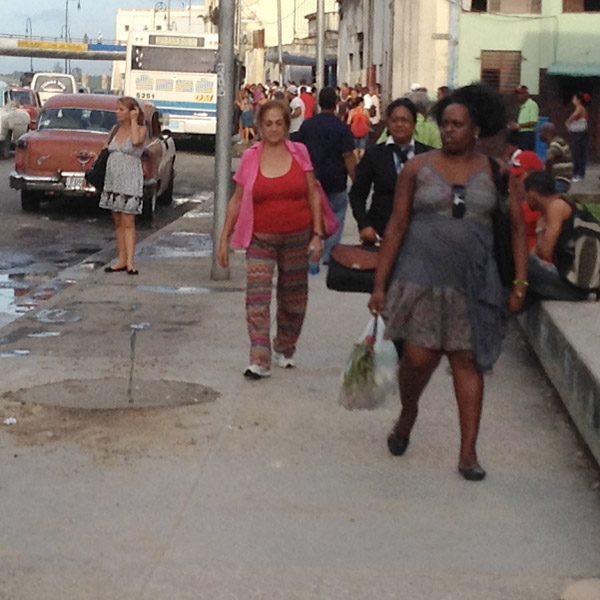
7. We wait at the bus stop for what feels like a sodding bloody eternity. The hardy feminist LGBTQ activist Yasmín goes so far as even to apologize to me. She later turns out to be an absolute stalwart, a true friend. I say it’s OK. But it’s not. “Every city has its own ways, please don’t feel bad,” I say, truthfully. And imply: when in Rome, do as the Romans do. But I’m seriously concerned about how much worse it’s going to get, if this is only the beginning.
8. Eventually we give up on the non-arriving bus and run off into the still-heavy rain. Yasmín hails a weird little taxi with a pick-up and canopied back section into which I have to squeeze, doubled over, past the legs of Cuban twentysomethings who look at me most quizzically and immediately make me realize what a fatuous old geezer I must appear to them. Eventually, after clambering, hunched, off the pick-up and almost falling onto the wet street with an overbearing, give-away flurry of leather straps in my wake, we get off, and now simply walk bravely through the very hard rain, resolute. Welcome to Cuba, where getting around is often less than simple. We arrive, at last, at a high and wide door-front right on the sidewalk, and Yasmín rings a bell. Home at last? Dripping wet. A humble Cuban casa particular. Cándida Matos Matos. Renta de Habitaciones para Extranjeros. San Lazaro No 1001, Centro Habana. (Later, I learn that this is a “very wealthy” area, though it looks pretty old and run-down.) I understand now, too, that I am an extranjero, and I certainly feel like one. I am shown to my modest, and somewhat bare, room, with a hard, uneven bed at an angle in one corner, no table or chair at all, an old Singer sewing machine in another corner(for decoration?), a little bedside stand with three small shelves, and an old-fashioned, dark, stand-alone wardrobe such as I remember from my childhood in the third corner. I am shown a bathroom, “just for me”, which has no toilet seat on its toilet (they’re all like this, toilet seats soon seem unnecessary to me), but at least I am indoors, and dry, and there appears to be a shower. I unpeel my sopping wet clothes from The Fifth Collection and make a bee-line for it.
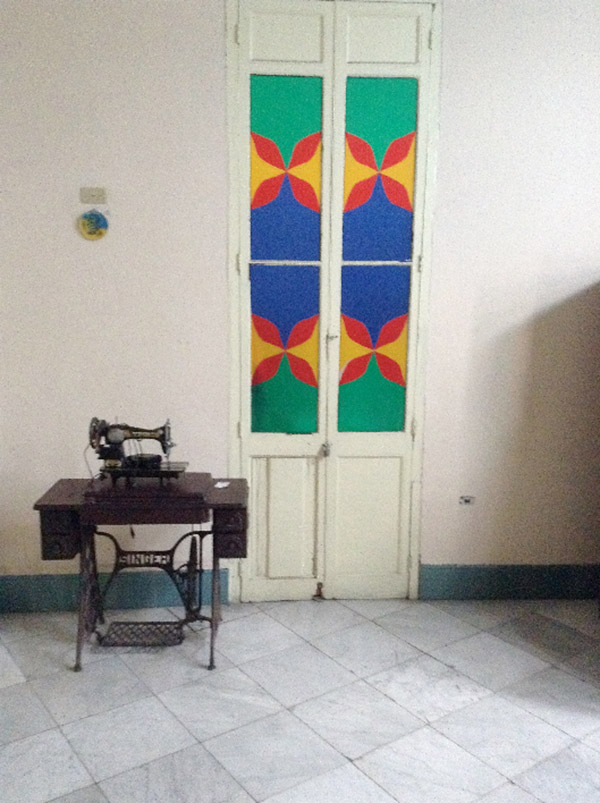
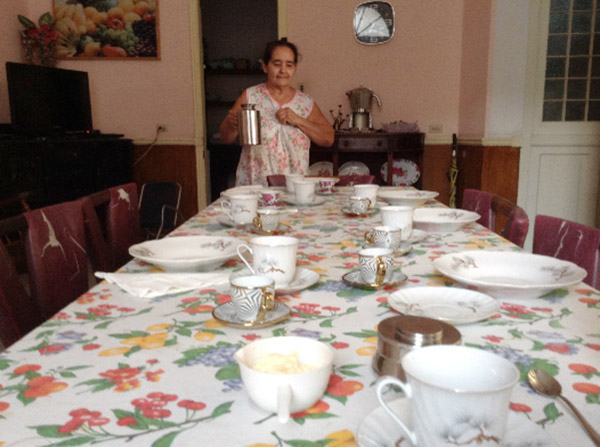
9. Did I really expect there to be hot water, or even a strong water-flow? I realize now that it’s true, this line that’s been popping up in my head all day, ever since arriving in Cuba: it’s not going to get better in a hurry; this is just the beginning.
Monday 5 November
10. It got better, though. As always, it is the traveller who must fit into his new surroundings, not the other way around. It got so much better that there was just no time to write.
Tuesday 6 November
11. It got better partly because I decided to drop completely my fussy preconceptions about what accommodation should feel and look like, and get into the spirit of Havana. If I really wanted to, I could complain about the enforced sociality that goes with conferencing, even at an “unconference” – endless megabytes of it, thousands upon thousands of remorseless seconds of joke-making, talk-swapping, straw-grasping gambits at talk, smart-talk and more-talk, with virtual strangers, a business at which I am just no good, quite obtusely useless, in fact – but I won’t so complain, because this reality-warp was doing something very different, and infinitely worthwhile, to me (the value is always outside the conference session itself): giving me an on-the-skin sense of what it might feel like to live a different life, in a different time, as a different social and historical being.
12. Granted, many things are not so good in Havana: they don’t get to eat a lot of meat (especially beef) because it’s rare and expensive; ditto vegetables, salad greens and even potatoes, I am told (they eat a great amount of refined starch); the plumbing is a bit rotten; the power snaps off at least once a day; traffic is diabolical, with the loud old skedonks spewing unconverted lead into the air; the narrow, old streets are choked and public transport seems badly congested. And so on. Lots of “inconvenience” and old-fashioned bustle on the mid-20th Century streets.
Suspended modernity & CYBER-LESS LIFE [13-16]
13. The apparent downside of a city like Havana is the obverse of what’s deeply romantic about the city, though to objectify it in such a manner is dangerous. In what other major city is one forced to escape hyper-modernity and near-universal connectivity? Where else do you find a famous cosmopolis where human cyborgs do not live half-avatar lives, half-present, half-absent, in a perpetual cloud? A mist of distractedness, both internally and externally (an excuse for ducking conversation, especially when it’s awkward, I quickly realize, at the same time missing acutely the ducking-hole myself). Where else can you encounter a deep heartiness of spirit, in people who are various shades of black (escape the whiteness prison-house! escape racial awareness, for the most part!), and who share at least minimal linguistic and cultural homogeneity? With one undisputed national sport? (Baseball. Weird, since the Cubans are so anti-US, where baseball is also king, but one gets the feeling they would love to smash the Americans at their own game.) Sure, diversity and difference are the great new virtues, not homogeneity, but for a person from a country that desperately needs a little more uniformity of outlook, perspective, ideology, mood, language and general economic status, this locked-in Cuban world can begin to look very desirable. (Better-informed scholars on Cuba will no doubt correct me on this score: there are pervasive social schisms and incommensurate heterogeneities in Cuba; my perceptions betray a distinctly South African nostalgia for common origins.)
14. More to the point, however, is the invigorating throwback to a world of social heart-and-soul, in a time before universal connectivity so radically changed the social sphere into an ethereal, borderless place where locality of place is often compromised. So, here is a world of “real” heartiness, Latin rather than Protestant in temperament, plus rum and cigars, if you get what I mean. (I do not suffer well the bland hypocrisy of pervasive fake-heartiness in my more uptight professional academic world back home, both on email and in person.) The waiter-barmen at last night’s “nightcap” last-stop bar (many strong “Cuba Libre” rum cocktails) were like something out of a Frank Sinatra movie, as if the very point of living was to be bass-note sociable, welcoming, generous, and thoroughly outgoing in disposition. Ernest Hemingway stuff, perhaps. The Cuban rum we were sinking so merrily was served in lavish proportions. The mucho-sweet local version of “Coca-Cola” in fact took up only a third or less of the glass; the rest was rum, ice and lime juice. (This must be the only country on the globe that has no Coca-Cola, to which I say, “well done, Havana!”)
15. It may be a moneyed tourist’s illusion to think that it’s fun living in a retro version of modernity; this may well be an ironically bourgeois indulgence for those of us who can get out of jail after a week. After all, my new American friend Edie Meidav, who has written a novel about Cuba (also author of Crawl Space and Lola, California), calls Havana a “beautifully outfitted prison”. But allow me this indulgence for a short while, because I do think there is a great deal of merit in being forced back into social presence when out and about, and especially when talking to other human beings. I sat at a local bar and watched one or two couples drinking and chatting. It wasn’t only that neither of them was checking their gadgets intermittently, doing halfhearted talk during lags in cyber-(s)hopping; it wasn’t just that they were forced to be in their real skins, looking through their real eyes, and looking, looking out, both visually and for the presence of others, the feel of others, not anaesthetized against this; seeing beyond a threshold of a few feet and able to see the sea crashing over the Havana malecón (sea-wall) across the street; it was something else, too: they seemed to be more with each other, if that makes any sense; more invested, or perhaps more trapped, more bound and bonded, in the entire duration of each real-time moment, and less able to skid under the weight of time and space via handheld foefies, as they say in Afrikaans (although I’m sure I would quickly begin to long for said gadgets). It somehow felt more old-fashioned, in a way that must have as many disadvantages (boredom?) as advantages, but for the time being I was inclined to see the advantages, inclined to be more accepting of life in this very special, strange city.
16. It is special and strange also because, even amid the deep texture of decay everywhere, it is a most comely city. I mean this not only about the old Havana area with its Stonetown-like feel, its medieval feel and neoclassical Spanish architecture, but also about the texture of the more general city outside of the tourist spots. I walked about in ordinary Havana at night, alone, and despite the material feel of age and rotting, the patchy streetlights and many dark corners, the streets felt quite unthreatening. Havana is mostly a safe city. People appear to be friendly, and they seem more inclined to smile than to grimace, despite their material and cyber deprivations. Is this what happens, I wonder, when the income gap is minimal, when everyone, or most of everyone, is more or less at a comparable class-level (lower middle or working class)? There is much variation, of course, but it looks as if Cuban society is nowhere near as assymetrical in wealth levels as the US, for example, or Russia. For a South African, the sense one gets of unthreatened community on the streets is almost unbelievable, reminding me how we have “lost” our cities; how we have allowed them to become hideous car-traps where the vehicles get hijacked and bag-snatched in clear daylight, people often shot dead in the bungling process; many of us, especially in the postcolonies, inhabit cities that that have become largely inhospitable to the “common person”, the pedestrian.
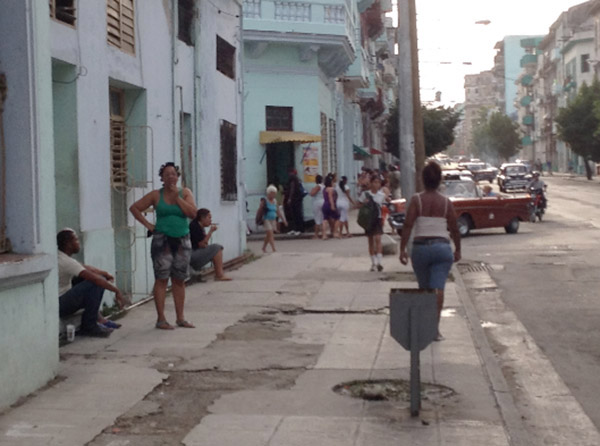
PROSTITUTE story [17]
17. At the bar a which I sat and observed Cuban non-cyborgs living it up, drinking and chatting in the “meat-world”, I had another experience of the old-fashioned flesh realm: an approach by an outrageously young prostitute. ”Girls” are all over the place in Havana; “you want a girl?” intermediaries ask you. This “girl” simply smiled at me shyly and asked if she could sit down at my table, after first asking unsuccessfully for a “light” to flame up her cigarette. My natural inclination to be “nice” (a bad old tic) saw me say, “yes, of course”, although we were communicating across a solid barrier (my lack of Spanish, her insensibility to English), and though the advance was unwelcome and awkward (my gratefulness to be alone, her perception of me as a lonely tourist). She was not dressed up to the nines in clichéd prostitute fashion. She was wearing plain, dirty jeans, and a skimpy T-shirt top. I motioned to the waiter, who had just served me in good English, and I asked him straight up: “Is this girl what I think she is?” He replied only half in the affirmative, saying “Maybe!” but wink-smiled in a giveaway manner. I replied: “Please tell her I am not interested in buying sex from her, but I will buy her a drink.” He translated. Her head seemed to drop quite dramatically upon hearing this, as if from the impact of an insult, or a put-down, but perhaps I exaggerate her vulnerability. I left soon after.
What is the ‘DIGITAL HUMANITIES’? [18-21]
Thursday 8 November
18. I am in Havana for one of a serial brand of gathering called THATcamp, as in THATcamp Caribe (there is a THATcamp Mexico coming up, and I am vaguely thinking about a THATcamp Cape Town). It’s an acronym for “The Humanities and Technology Camp” and these events are styled as “unconferences” – no solo, “star” speakers, no keynotes, no hogging the microphone, all campers together democratically voting on which of the proposed panels should get the green light (suggestions come from the floor, and/or on the THATcamp website before the time). It’s collaborative, constructive, democratic, and goal-oriented. OK, take this all with a healthy pinch of salt. This is the “DH” ethos, and, as in all human collocations of people, processes, and money, there are egos, power-plays and hypocrisies here too. But let’s allow the ethos to speak, in its ideational form at least, just for a brief while.
19. So, in the “Digital Humanities”, where hype is both an ever-present danger and a means of securing the big clots of funding needed for projects, the general ethos is built around the idea of goal-oriented collaboration. Even with politics and egos acknowledged, you still can’t do a DH project without crossing both disciplinary and institutional lines; that is, you can’t do it just in the arts and social sciences faculty, or even just among academics; you need librarians, geeks, “citizen scholars”, data experts who are invested in the humanities, institutional allies such as Deans and even higher-ups, and yet others from still more heterogeneous institutional and social sites. The world of digital affordances is a world of connectivity, period, and you simply cannot work in a cloisters-within-a-monastery model, such as the university has often done in the past and in many cases continues to do. In a “DH” environment (“DH” is an acronym I use somewhat reluctantly because of its hype-propensity), and especially at a THATcamp gathering, the object is not quite so much the symbolic exchange (and arbitration) of scholarly prestige – as many more “straight” conferences indubitably are, to a great extent – but the achievement of goals that become possible only via (putatively) humble and (supposedly) less ego-freighted teamwork. The goals themselves are correspondingly more complex, in fairly direct relation to the more cooperative attitude required of the team-workers.
20. This, again, is because the DH proposes processes and projects that require multifaceted input, including text mark-up for computational purposes, data programming, conceptual and interface design (both visual as in website and conceptual as in site-functionality design), intellectual project leadership, project management, grant-writing skills, and more. Harvard’s elite DH centre, metaLAB, for example, says it is “a community of scholars, artists, designers, journalists, technologists, architects, and students engaged in team-based experiments that merge research, teaching, publication, social action, and the use and development of digital tools”.
21. Barring failure, which is encouraged for learning purposes, a good DH project will eventuate in a single visual portal that opens up multiple possibilities, a bit like Aladdin’s Lamp. One or two examples: “The Emotions of London” is a project in which data mining and what the makers call digital crowdsourcing account for a “map” of the English metropolis, “charting the affective significance of all the place-names mentioned in our archive of novels”. Another example: “Loudness in the Novel” uses data-mining to chart the “semantics of loudness” and affective stylistics in a digital archive of thousands of 19th Century novels. Or you can see how Moretti’s Literary Lab has come up with a “taxonomy of titles in the 18th Century literary marketplace”. For more interesting browsing in this regard, go to the Roy Rosenzweig Centre for History and New Media at George Mason University; hyperstudio at MIT; Scholars’ Lab at the University of Virginia; metaLAB at Harvard University (http://metalab.harvard.edu/); MITH (Maryland Institute for Technology in the Humanities; and the University of Alberta’s TAPoR, among others. One of the most accessible introductions to the DH is an open access, entirely free digital book called DIGITAL_HUMANITIES by leading figures Anne Burdick, Johanna Drucker, Peter Lunenfeld, Todd Presner and Jeffrey Schnapp.
THATcamp CARIBE 2013 [22-26]
22. Back to Havana and THATcamp Caribe 2013, where we’re attempting a distillation of the above within a gathering that has been denuded of all but three of its US (and English-speaking) contingent by the US government shutdown of October 1-16. The shutdown (occasioned by a stalemate in the US Congress between the Democrats and the Republicans) prevented most of the US delegates from getting visas in time. (Relations between the US and Cuba remain chilly, to say the least. South Africans and Cubans, on the other hand, are natural allies – I kept telling Cubans how many of us who supported the ANC before 1994 sympathized vigorously with the Cuban revolution, and that South Africans seemed to dislike American swagger at least as much as the Cubans did.)
23. The majority of the participants at THATcamp Caribe 2013 were thus Cuban, and so the proceedings were (correctly) skewed towards the needs of that majority. And here some big ironies emerged: Cubans have almost no internet to speak of; the whole archipelago shares a very limited amount of connectivity; private people – the few who do have web connections – have dial-ups and modems, which are very slow, as some of us might remember from the 1990s; only hotels and other big conglomerates (like the inefficient one-party Cuban government) have connectivity in any reliable sense, and even then it’s slower than what’s available in the developed world.
24. Doesn’t this render the idea of the “DH” an oxymoron? Doesn’t this fact in itself contradict the claims of DH people that their politics is “open”, seeking always open or universal access, and conducting war against copyright and other restrictions on free and widespread dissemination of knowledge? Well, yes and no. Yes, for the obvious reasons, in that high-end, high-hype DH requires vast resources of money, skills and technological capacity commandeered mainly by major institutions such as Harvard, MIT, Maryland, Virginia and others in the US, Canada, the UK (King’s College, London, and University College London, where they offer MA’s in DH, among others such as Oxford University), Europe, Japan and Australia (where it’s also big, see Aus-e-Lit, a massive Australian-literature digital repository at the University of Queensland). No, because, as THATcamp Caribe 2013 coordinator Alex Gil (responsible for the Digital Humanities programme at Columbia University) and others present argued, it’s about the data and the computing, not the means of conveyance, so you can – for example – physically bring data-sticks into a place like Cuba (and many other developing-world countries in Asia, South America, Eastern Europe and Africa), and thereby teach people about the “tools” – to plug into their PCs – that are so central to the DH for doing things with and in this version of the humanities.
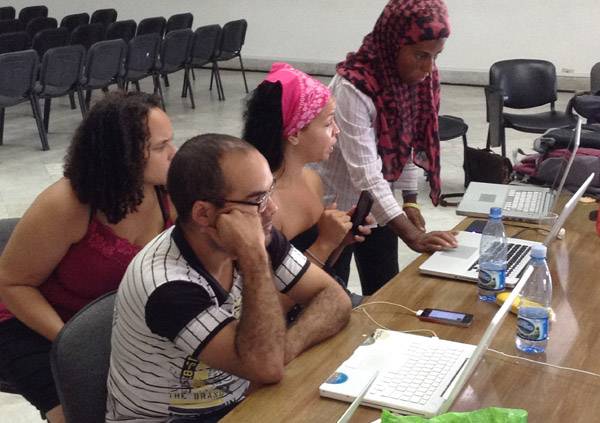
25. Of course, you don't just teach people in the “Third World” the tools, you also learn from people in less technology-funded economies, in a mutual interchange. The level of equipment and funding doesn’t necessarily correlate with know-how and skills. The politics of the DH, or so argues Gil (a scholar of Aimé Césaire) and others of similar persuasion, is the politics of remediating or bridging the “Digital Divide”, and of challenging un-self-aware knowledge hegemonies wherever necessary. It is also to take on, in small but meaningful ways, the wealth and the technological gaps that are so debilitating for people in what used to be called the “Third World” (and, to some extent, the “Second World” too). It is a politics of “democratising” knowledge, to use a term familiar to South Africans, and of making both the content as well as the tools of knowledge available and accessible outside of the cloisters of entry-protected universities, regardless of which part of the world they’re situated in. (All of these arguments are hugely controversial, I know; this, however, is more or less their ideational form.)
26. So, the Cubans, many of them journalists and writer-activists, wanted to talk about the “new” journalism, in the context of the new media; about copyright; how to optimize the visibility of one’s own blogs, posts, websites and so on; how to access digital tools, and to use them – all topics that speak to a burning need to break the chains of nation-state regulation of media and communication. Cuba, like the rest of the “Global South”, may well be transnational in theory, but its people know all too well the power of borders, and border-restrictions; they know all too well the thick narrations of nation, and their implicit tyranny, especially in a country where no one dare question the Revolution too loudly, because it is universal symbolic capital, so the real struggle is, of course, over the appropriation and interpretation of the revolution, just as it is in South Africa with the “Struggle”. “Post-nationalism”, like modernity (and postmodernity), remain very uneven phenomena, especially in places like Cuba and South Africa. I felt the power of the “border” quite viscerally in Atlanta on my way back from Cuba when I was pulled aside, told to wait in a soundproof room to one side like an asylum-seeker, and most impolitely interrogated in three successive bouts of dart-like questioning, about my movements and intentions with regard to the US; I was accused of being an “intended illegal immigrant”, and eventually given a brusque diktat about the exact date by which I had to leave my wife’s apple-pie-and-cream homeland, also home to McCarthy and the Klu-Klux-Klan.
27. I left with very warm feelings for Cuba, and I remain fascinated by Havana. Conditions in Cuba are not ideal. The activists I met there, especially Yasmín and Luis, have many issues with the way things are coordinated, controlled, mediated and filtered by a government that by all accounts seems to operate like a god-given entity. Still, the spirit of the place is infectious, and I felt, upon leaving, that I wanted to go back to live, if only for a few months, but preferably for longer. Living in a city for more than a month or two is, for me, the only real way to get to know it (even if just a little) from the inside. That’s my experience, at least. If I could, I would stay long enough to learn passable Spanish, which is a most lovely and desirable language, and begin to read some of the Cuban poets. I would reflect on the many strange similarities between Cuba and South Africa: in both, national narratives continue to shape daily perceptions and experience in a way that belies the claims of postnationalism and poststructuralism; in both, a burning nostalgia, an ache, for the lost virtues of a long-gone revolution, is evident; relations with a clearly demarcated “outside” world continue to be international and assymetrical rather than transnational and flat, for all but the most privileged upper crust; modernity and its lip-licking gadgets, cars, e-money and plastic credit are often well out of reach for the poor majority in both; and yet both countries treasure their struggle icons, and still feed off old, destiny-defining antagonisms, not to mention the manna of righteous rebellion: a luta continua! I would live in Havana and shake off the ennui that afflicts those who live beyond Fukuyama’s “end of history”, in the neoliberal global supermarket where to be “happy” is to consume comprehensively and where freedom is a fat wallet, the lack of which means only that you didn’t compete well enough in the market of competitive hyper-individualism and have only yourself to blame. Somehow, in a city such as Havana, or in Johannesburg for that matter, or even many parts of Cape Town, it seems as if there remains some history to reel in, some leverage for negotiation, for the struggle to rescue the past from forgetfulness. It seems possible, somehow, to beckon towards a still-better future, or even just the idea of such a thing. The idea of an improved future for everyone, rather than just the rich, has not yet suffered a miserable, traffic-choked death. The social space seems open, to some extent, for contention. In some places, the road still beckons.
JUST PICTURES (photo-blog)
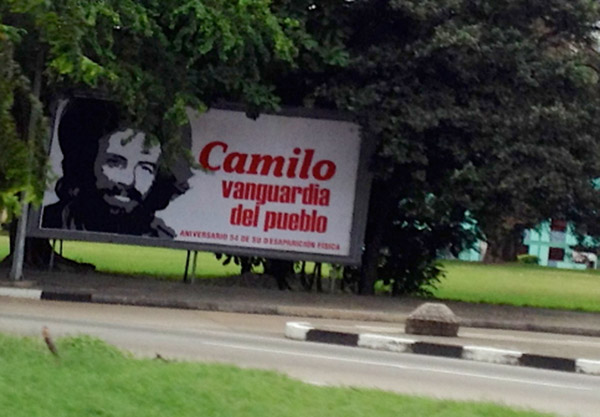
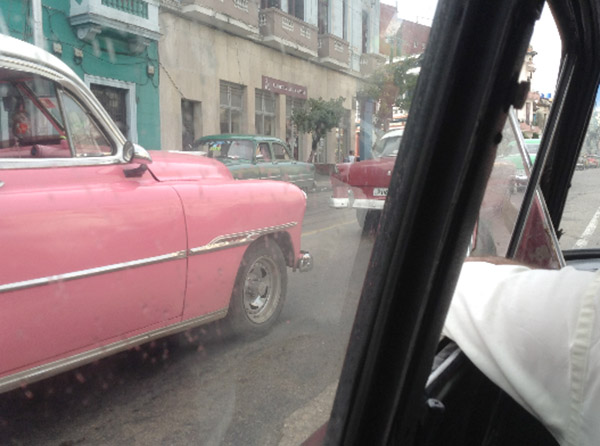




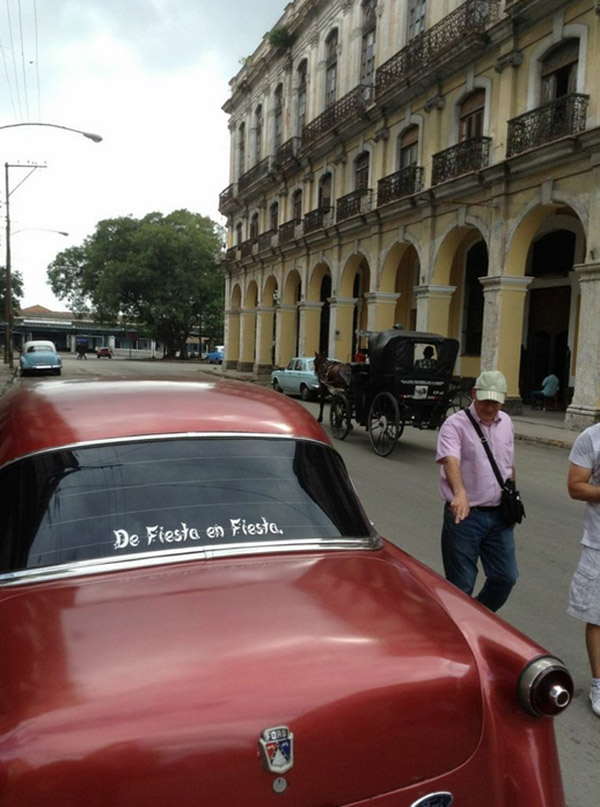


























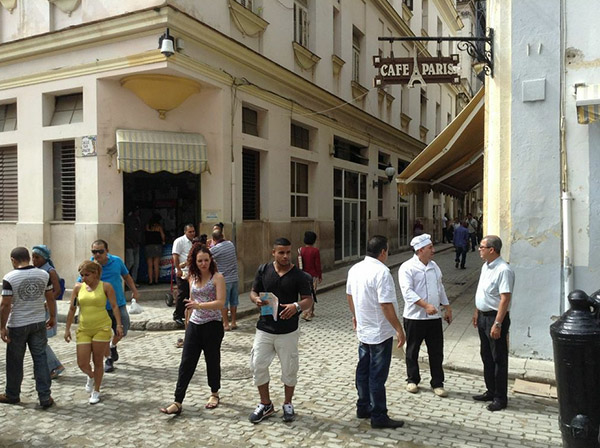
 SLiPStellenbosch Literary Project
SLiPStellenbosch Literary Project 